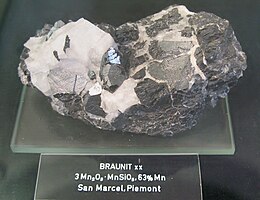| Braunite | |
|---|---|
 Braunite, from San Marcel, Piemonte, Italy | |
| General | |
| Category | Nesosilicates |
| Formula (repeating unit) | Mn2+Mn3+6[O8|SiO4] |
| IMA symbol | Bnt[1] |
| Strunz classification | 9.AG.05 |
| Dana classification | 7.5.1.3 |
| Crystal system | Tetragonal |
| Crystal class | Ditetragonal dipyramidal (4/mmm) H-M symbol: (4/m 2/m 2/m) |
| Space group | I41/acd |
| Identification | |
| Color | brownish black, steel-grey |
| Cleavage | {112} perfect |
| Mohs scale hardness | 6–6+1⁄2 |
| Luster | sub-metallic |
| Streak | black |
| Diaphaneity | opaque |
| Specific gravity | 4.72 – 4.83 |
| References | [2] |
Braunite is a silicate mineral containing both di- and tri-valent manganese with the chemical formula: Mn2+Mn3+6[O8|SiO4].[3] Common impurities include iron, calcium, boron, barium, titanium, aluminium, and magnesium.
Braunite forms grey/black tetragonal crystals and has a Mohs hardness of 6 – 6.5.
It was named after the Wilhelm von Braun (1790–1872) of Gotha, Thuringia, Germany.[3]
A calcium iron bearing variant, named braunite II (formula: Ca(Mn3+,Fe3+)14SiO24), was discovered and described in 1967 from Kalahari, Cape Province, South Africa.[4][5]
- ^ Warr, L.N. (2021). "IMA–CNMNC approved mineral symbols". Mineralogical Magazine. 85 (3): 291–320. Bibcode:2021MinM...85..291W. doi:10.1180/mgm.2021.43. S2CID 235729616.
- ^ Mineralienatlas
- ^ a b Mindat
- ^ JoHan P. R. De Viliers, The crystal structure of braunite II and its relation to bixbyite and braunite, American Mineralogist, Volume 65, pages 756–765, 1980
- ^ Mindat, Braunite-II